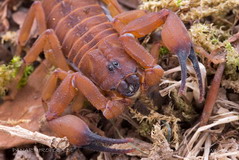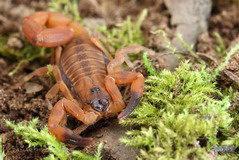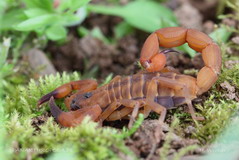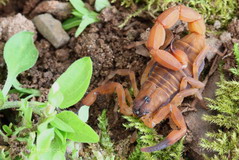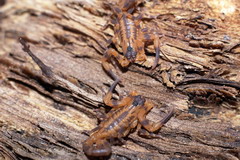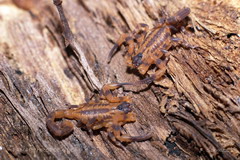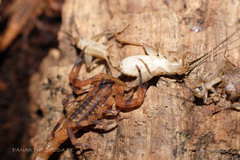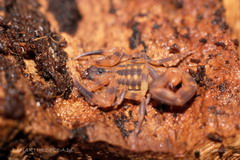- Akravidae
- Bothriuridae
- Buthidae
- Babycurus jacksoni
- Centruroides gracilis
- Centruroides meisei
- Centruroides nigrenscens
- Hottentotta hottentotta
- Lychas mucronatus
- Lychas scutilus
- Parabuthus pallidus
- Parabuthus raudus
- Parabuthus villosus "black"
- Caraboctonidae
- Chactidae
- Chaerilidae
- Euscorpiidae
- Hemiscorpiidae
- Iuridae
- Pseudochactidae
- Scorpionidae
- Superstitioniidae
- Troglotayosicidae
- Typhlochactidae
- Vaejovidae

Babycurus jacksoni (Pocock, 1890)
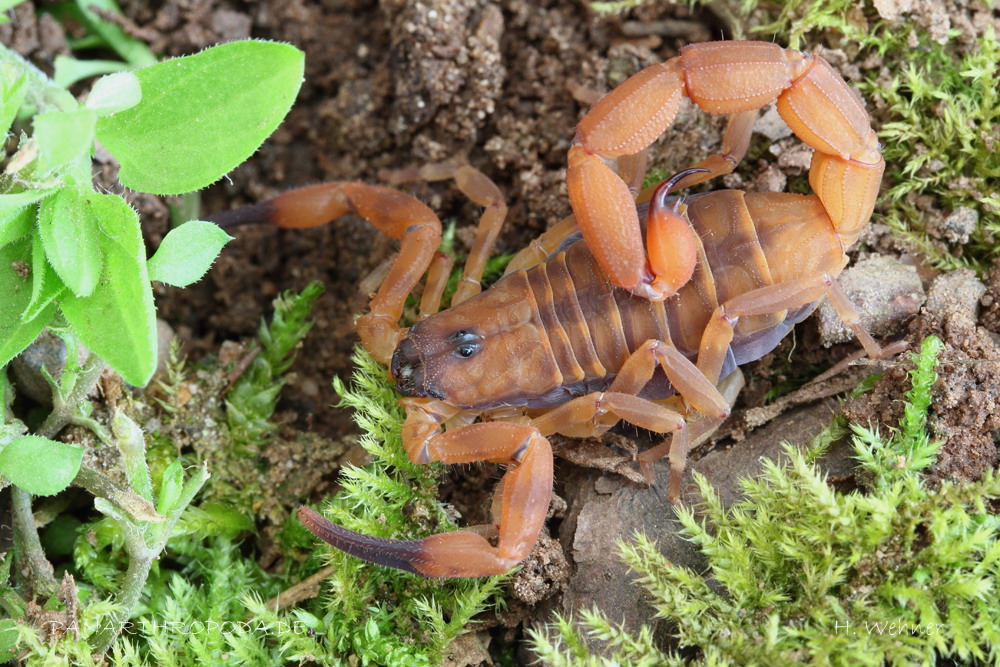
Subadulte female
Origin and occurrence
Babycurus jacksoni occurs in East- to Middle-Africa and has been found in Tanzania, Kenia, Uganda and the Democratic Republic of the Congo (Kovařík, 2000).
Appearance and sexual dimorphism
With 6 to 9 cm in bodysize Babycurus jacksoni is among the middle sized species of scorpion (Kovařík, 2000), however specimen bred in captivity usually stay at the lower end of this range. This species is of red-orange base coloration, that changes to a rusty brown with increasing instars. All segments of the extremeties including the pedipalp segemts show a centered brown coloration. Tibia and tarsus of the pedipalps are dark, too. The same goes for the mask of the carapace from the median eyes to the chelicerae. Three symmetrical dark brown stripes, which are framed by a more bright yellow-orange, run over the tergites. The metasoma is colored brown ventrally and in base color dorsally. All colors different to the base color will more and more weaken out with increasing instars.
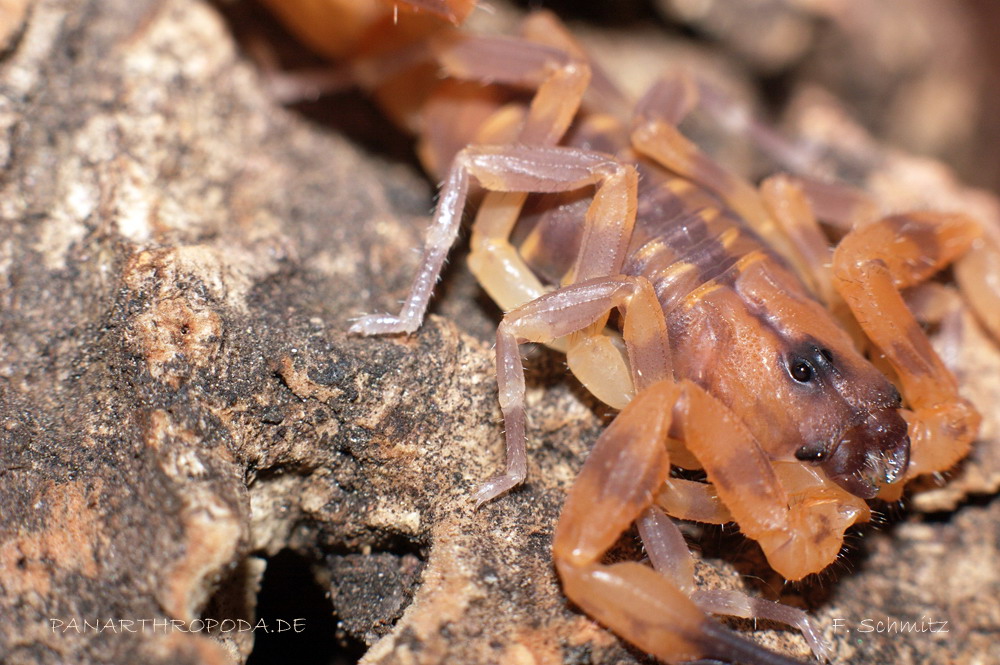
The brown colorations are well noticable in this juvenile
Babycurus jacksoni possess a subaculear "sting", a very distinct tubercle on the telson over the actual aculeus.
Due to its appearance Babycurus jacksoni is often confused with Odonturus dentatus. However, a distinction can easily be made by a closer look on the third pair of walking legs. If tibial spurs are present it is actually Odonturus dentatus, otherwise Babycurus jacksoni.
The sex of Babycurus jacksoni can not be determined by counting pectinal teeth, since both sexes have 18 to 25 of them (Kovařík, 2000). Juveniles do not differ morphologically, which makes sexing them even more difficult. They can only be sexed by the genital papillae.
Adults show a clear sexual dimorphism, in which the mani of the males are much more bulbous then the female's, in addition the overall habitus of the females is a bit more bulky, even though this is an doubtful method of sexing in some specimen. Between the rows of granules on the metasomal segments III to V, the males show very destinct granules, which the female does not (Kovařík, 2000). Sexing a specimen by this is not too easy, at least if no reference is available.
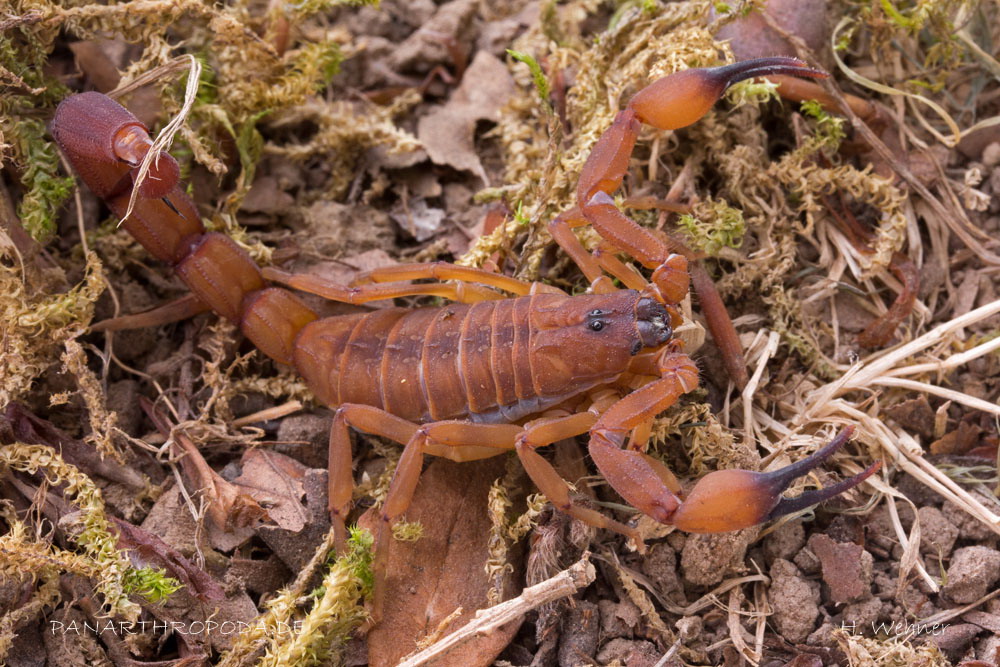
The bulbous chalae of the male are clearly visible
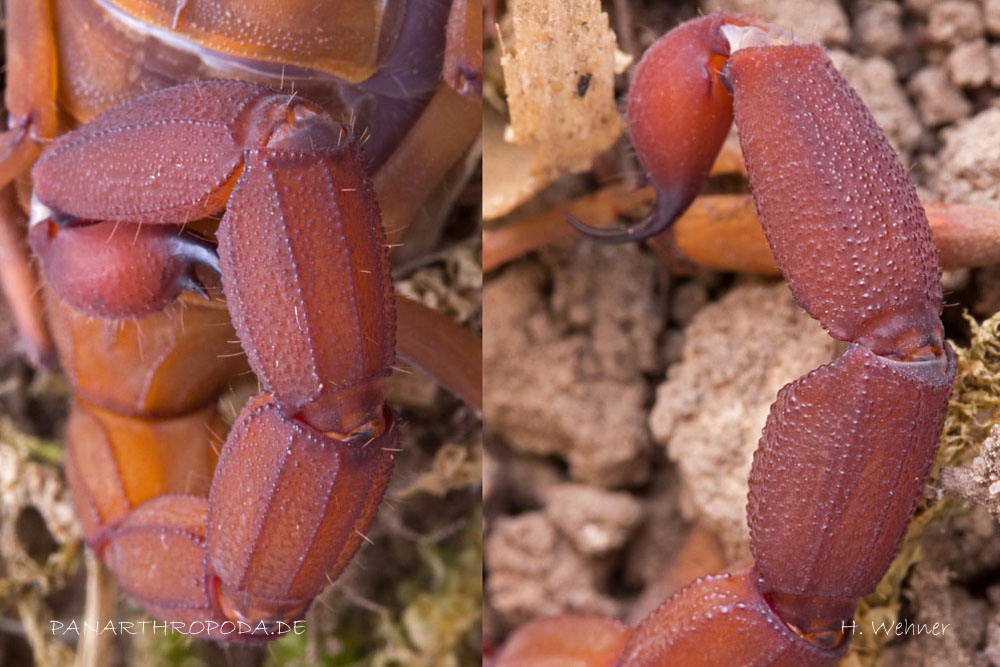
Sexual dimorphism of metasoma granulation. Male on the right, female on the left
Behavior
Babycurus jacksoni is a rather calm, inaggressive species of scorpion and is not too prone to disturbance. When disturbed they will mostly move away slowly and calmly and only move fast when the disturbance is intense (like when trying to catch them with tweezers). In the latter case, they are quick runners, which should be kept in mind. In addition, they show a rather rare behavoir for scorpions - they feign death. This, paired with its quickness makes Babycurus jacksoni unpredictable, which makes it only limitedly fit for beginners.
Amongst its fellows, Babycurus jacksoni is social and can be kept in bigger groups. Casualties due to cannibalism are in my case without exception limited to juveniles in molt, even though some keepers say otherwise. The animals are prone to aggregation and share their hideouts, even sitting on top of each other in some cases. The potential for aggression amonst fellows is low.
Keeping conditions
According to its habitat Babycurus jacksoni should be kept at 25 to 28 °C during day, dropping the temperatures to room temperature during night is okey, even though the night temperatures in parts of the habitat are quite a bit lower. Even though Babycurus jacksoni can cope with dryness rather well, it should be kept at around 60 to 80 % relative humidity. Parts of the substrat should be kept moist all the time. In relation to the keeping conditions this species is not too picky. I keep my specimen rather too wet than too dry and could not make out any down sides. Especially when they have to be left alone for a longer period of time, the substrat can be wetted thoroughly without a problem, so that the moisture will stick over many days to come.
A container of 30x20 cm² is sufficient for one specimen, one measuring 50x40 cm² can house about 6 to 8 specimen. Babycurus jacksoni does not dig, so the substrat needn't be higher than 5 cm, the type of substrat is not too important (Earth, humus and sorts are fine). Several pieces of bark and roots can be used as hideouts, under which Babycurus jacksoni will at most dig shallow pits and in some cases house with multiple specimen at a time. Clefts between the bark will be used as hideouts, too. I could not observe a destinct need for climbing in Babycurus jacksoni, so the bark I offer is stacked horizontally. Vertical pieces for climbing can obviously be offered non the less.
A bowl for drinking is not necessary when the specimen are kept properly moist, I have only seldom seen attempts to drink out of a bowl.
Babycurus jacksoni can be fed with the "common prey items" without a problem. Feeding every 2 weeks is sufficient for adults, even if kept in groups. I have not had any casualties using this frequency of feeding.
Mating and raising the young
Babycurus jacksoni is bred without much problem and is therefore easily aquired not as wild catches but as young bred in captivity. The female will litter as soon as 3 months after a successful mating and when kept properly can produce between 25 and 35 offspring. These values are regularely recorded in my case under the above mentioned conditiones. Since this species is capable of amphigonia retardata, that is the females can store up sperm, they can litter several times without any more matings occuring. Increasingly smaller litters are to be expected, however. The capability of amphigonia retardata is to be kept in mind when keeping this species in mixed groups, because even after seperating the sexes a good deal of young can pile up nevertheless.
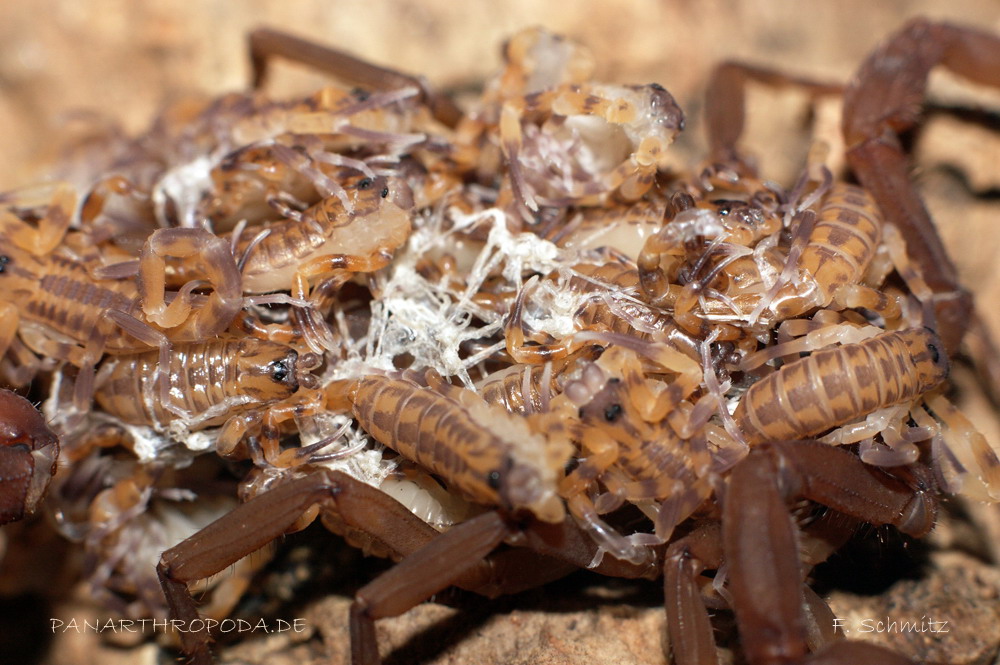
Mother with young in first and second instar
The young will remain on the mother's back for about one and a half weeks after which they are skillful hunters, that do not shy away from bigger pray. In second instar they can be fed with small crickets about their own bodysize. The young will grow properly under above mentioned conditions and can be raised in groups when the space calls for it. In this case one has to reckon with some casualties due to cannibalism during molts. I have always used this method and utilizing their tendency towards aggregation have kept about 30 young in double the space of a common cricket box starting at instar two (I have obviously reduced the quantity of specimen with increasing instars). When fed two times a week the casualties due to cannibalism where quite moderate (about 10% in total). When one needs or wants all of the young to survive at all costs, raising them in groups is not a good option, however.
The males will reach adulthood in 5th or 6th instar, which manifests with the bulbous mani. The females will reach adulthood in 6th instar. Raising Babycurus jacksoni from birth to adulthood in a little over a year is possible.
Interestingly enough only very few females appeared in my broods. I am not aware of the reasons, but perhaps those few cannibalized specimen where predominantly male.
References
Kovařík, F. (2000). Revision of Babycurus with desciption of three new species (Scorpiones: Buthidae). Acta Soc. Zool. Bohem., 64, 235 - 265.
F. Schmitz, authored 2011

